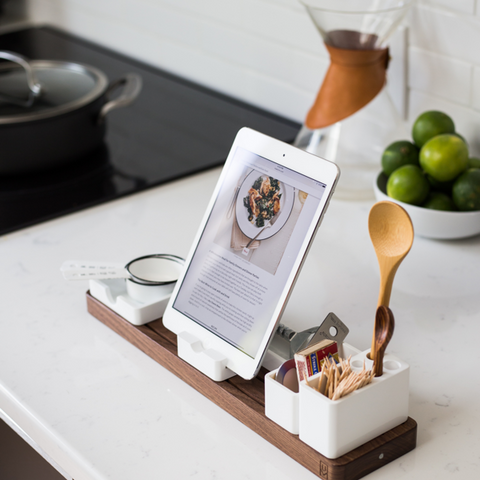I've been referring to Niki's story on The Science of the Best Fresh Pasta since long before I actually started working at Serious Eats. Why? Because it's the most comprehensive homemade-pasta primer on the internet (that I've seen, at least). Within, you'll find exhaustive research on pasta-making techniques, clear photos to illustrate the process, and definitive recipes that work, no matter how meltdown-prone you are in the kitchen.
If you have a little pasta-making experience, it's true that, as Niki says, all you reallyneed is flour, eggs, and a rolling pin. (Though any type of rolling pin will do in a pinch, a dowel-shaped one is ideal for rolling pasta dough by hand start to finish, as well as thin cracker and pizza doughs.) Still, let's just say that most home cooks will benefit a great deal from some additional basic tools. We have a fair few that we rely on to create nonna-style fresh pasta with a minimum of stress.
A KitchenAid Stand Mixer and Pasta Attachments

[Photograph: Vicky Wasik]
If you're looking for a good arm workout, you can certainly make Italian-style fresh pasta with a rolling pin alone. But it's a long and laborious process, so, if you prefer not to sweat through your apron, we highly suggest procuring a stand mixer and pasta-rolling attachments. With a little bit of practice, you can use these two pieces of equipment to make smooth sheets of dough, rolled to your desired thickness, and then slice them into delicate, even ribbons, all in a matter of minutes.
For a full rundown of how the rolling situation works, see the step-by-step photos here. Essentially, once you've flattened out the dough sufficiently by hand—you can use a regular old rolling pin for that step—you'll pass your dough through, starting at the widest setting (usually 0 or 1), until it's thin enough to cut. If you're making, say, fettuccine, you'll roll it to about a 6, or the third-thinnest setting. After that, just attach the fettuccine cutter, feed in a 12- to 14-inch section of dough, and voilà: your very own fresh pasta.
We know stand mixers are pricey, though. If they're outside your budget, a manual pasta machine is an excellent alternative. Sure, it does take a little more effort—and you might need a buddy to feed the dough in as you crank—but the results will ultimately be just as attractive and delicious.
A Bench Scraper

[Photograph: Vicky Wasik]
Throughout the pasta-making process, you'll run into plenty of occasions when a bench scraper will come in handy. When you're kneading, a bench scraper is perfect for removing any sticky dough from your hands and the mixing fork. Once the dough has formed and rested, you can use it again to cut the dough into sections. And finally, after the dough's been rolled, you'll turn to it again to portion the dough into manageable sections (unless, of course, you're determined to see what a pile of 24-inch spaghetti looks like).
Just because a bench scraper is useful for pasta doesn't mean it's a unitasker, though. Once you have it in your kitchen, you'll put it to work for all kinds of jobs, like moving piles of chopped vegetables from board to bowl, or from board to skillet. It's also handy for cleaning scraps and residue off your cutting board before the next round of chopping.
A Rimmed Aluminum Baking Sheet and Parchment Paper

[Photograph: Vicky Wasik]
Rimmed aluminum baking sheets, also referred to as "sheet pans" in the biz, are an essential for any kitchen—we use them to bake cookies and roast chicken, and as a portable spot where our Thanksgiving pie can cool. But for pasta-making, a baking sheet is the perfect spot to keep unrolled dough (make sure to cover it with a kitchen towel or plastic wrap to keep it from drying out), and for safely housing your rolled dough before you cut it into...well, whatever you plan to cut it into. To ensure that nothing sticks to the baking sheet, we also recommend stocking up on some parchment paper—precut is our preference.
A Scale
When you're measuring out your ingredients for pasta, we strongly recommend using a scale. Yes, measuring cups work just fine in many recipes, but a scale is far more accurate—and, when your ingredients are few and the ratio is so important, as in pasta-making, you need to be accurate. Using a scale also makes measuring easier: Simply place your mixing bowl on the scale, tare it, then add as much flour as you need to hit the right number.
We're big fans of the OXO Stainless Steel Food Scale, which has a backlit pull-out display, excellent accuracy and precision, and a removable stainless steel surface. Once you have a scale, you'll find it essential for all sorts of cooking and baking projects, including making your own pizza dough and impressing your friends with Stella's easy apple pie.
A Ravioli Cutter 
[Photograph: Niki Achitoff-Gray]
Feeling more like ravioli—stuffed with butternut squash, perhaps, or fresh ricotta—than simple fettuccine? No problem. For that, you'll just need to roll the dough out a notch thinner, until it's delicate and translucent (remember, you'll be biting into two layers at the edges!), then get out your ravioli cutter.
To use it, place a sheet of dough over the metal base, then gently press the plastic mold down to make depressions. Remove and fill each depression with just about a tablespoon of the filling of your choice. Cover with a second layer, flip the mold, and gently peel away the dough. To cut out your ravioli from there, you can use either a knife or a pretty fluted pastry wheel. If you don't have a ravioli cutter and you plan to shape the little guys by hand, you'll also want a pastry brush to moisten the edges for a tight seal.
Inspiration

[Photograph: Vicky Wasik]
While we strive to provide you with plenty of information on making your own pasta, it can never hurt to do some extra research, and that's where some of our favorite cookbooks come into play. We love Mastering Pasta by Marc Vetri for its step-by-step photographs that take all the guesswork out of pasta-making fundamentals, like mixing and kneading, along with the harder stuff, like pleating teardrops for corn- and cheese-stuffed culurgiònes. Then there's Pasta by Hand, which is completely devoted to the art of making pasta—you guessed it—by hand, from orecchiette to pillowy gnocchi. You won't need a fancy KitchenAid for the recipes in these books, but we still think that pretty, shiny mixer is well worth the investment.










